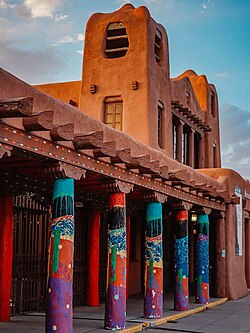An Indigenous Take on Women in Art
- Lucy

- Aug 2
- 4 min read
Last week, I shared part of the presentation I helped create for the New Mexico State Committee of the National Museum of Women in the Arts (NMC). It outlined women in Western art history and how that story led to the creation of the National Museum of Women in the Arts. If you haven't read it, I recommend doing so before continuing, as I'm sharing the Institute of American Indian Arts (IAIA) audience's thoughts on it today.
On Tuesday, July 29th, Susan Roden (NMC Secretary), Lynette Jennings (NMC Program Director), and I made an hour-long presentation to the graduate students of the IAIA master's program in Cultural Administration. There were approximately 30 students in the audience of all ages and Indigenous demographic backgrounds from all over the United States. Some came from as far west as Alaska, and others came from as far east as Vermont. Their degree is earned mostly through online classes, but once a year, they meet in person for discussions, workshops, and presentations.
Approximately 95% of the audience was women.
The presentation itself went very well. I started it off by talking about the history of women in art (at least in the Western art world). As you may recall from the outline I shared, the presentation started out with asking questions if anyone had an artist in their family, if that person was female, if that person was not white, and if that person could make money with their art. Much to my surprise, the vast majority of the room kept their hands up to the last question.
Then we asked them if they could name 5 women artists, and almost every hand went up in the room.
After my section was finished, Susan talked about the NMC, and then Lynette talked about how we are planning future programming before opening up the floor to discussion, and this is where it got really interesting.
Several audience members shared that their Indigenous communities have a very different perspective on both what art is and women in society. One woman encouraged everyone to expand how we think about art to include everything from making a meal to caregiving, to other acts of community. In effect, seeing art as life.
She continued to talk about how artistic practices are passed down from mother to daughter, and everyone is encouraged to create art. In fact, women creating art in the norm in their society and it is valued by the community.
Another woman spoke about how women's voices and leadership are highly valued in her community. And, if she sees a room of men making decisions, she instinctively feels the need to join them and make sure the decisions being made consider the entirety of the community: new mothers, children, grandparents, etc. That way, "they get it right".
She noted that women have been leaders in Indigenous societies for 100s of years and can provide an example of how non-Indigenous people can improve our societies.
Additionally, they talked about how the things that make women unique are valued and how they really hope to see more women feeling empowered and valuing themselves. One woman said they think Western society could benefit from listening to more Indigenous voices, perspectives, and ideas.
I wrote down this note: "Indigenous peoples have the answers for contemporary society's ills".
Another person pointed out that often Ingenious art is born from their culture and for economic survival, not from being inspired by other artists, or by an experience in nature, or because creating art pleases them.
One woman shared that she visited the National Museum of Women in the Arts about a year ago with a friend, and they looked for Indigenous art being displayed and only found 2 or 3. So she encouraged us to look at the National Museum's collection and advocate for more Indigenous art to be included.
Another person asked if there were any Indigenous people on our board. We acknowledged that there are not, but that we would like to have them, and encouraged anyone who lives in New Mexico to come talk to us after the presentation.
Lastly, we asked how we can help them, and the answer that got the biggest response was just to give Indigenous people a sounding board. Invite them to speak at events, meetings, and programs.
We ended by thanking them and encouraging them to reach out to committees wherever they live and, if they live in NM, to talk with us. Afterwards, two women came up saying they live in NM and asked for our cards. I encouraged them to contact me so we could talk more and find ways to partner.
When I got home and was telling my husband about the presentation, I shared that during the discussion, I got the feeling the audience members felt sorry for us. Why? Because it was obvious in the presentation that Western women artists have not and are not respected.
And I felt sorry for us too. Our history is full of stories of women not being appreciated and being actively kept away from leadership and decision-making. Of course, there are many stories of women overcoming society's systemic patriarchy, but compared to the total number of women in history, those stories are a small percentage and are often ignored by historians and not taught in school.
By the way, the podcast "The Lost Women of Science" does an excellent job of finding stories of women scientists who helped create the world we live in today, but have never been given credit for their work or had their stories told.
Anyway, the audience's feedback has given me a lot to think about, and now, dear reader, I hope it's given you something to think about too.







Comments